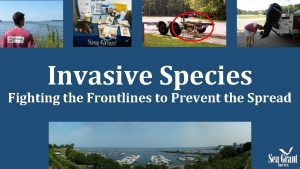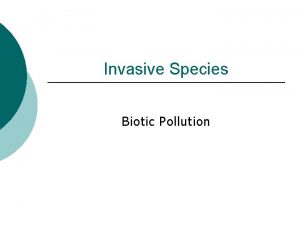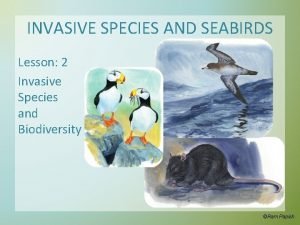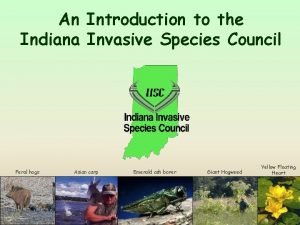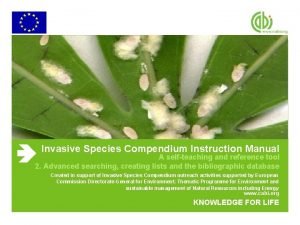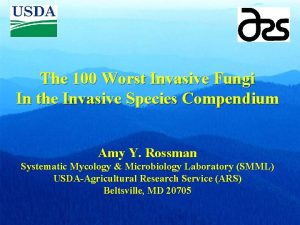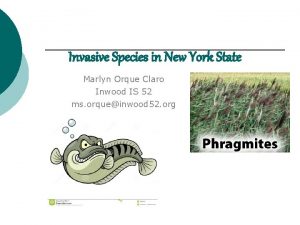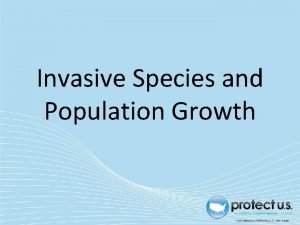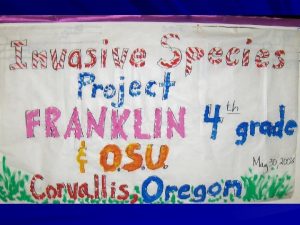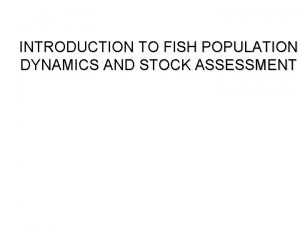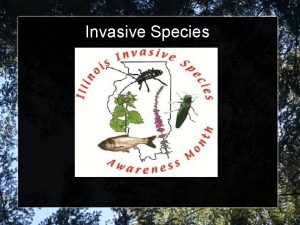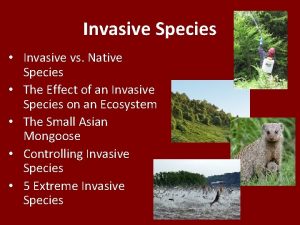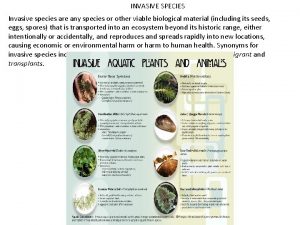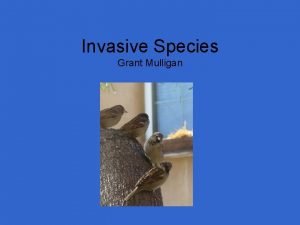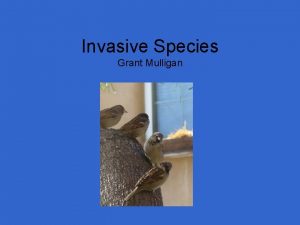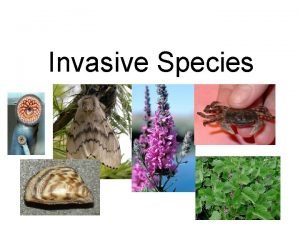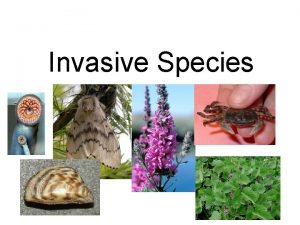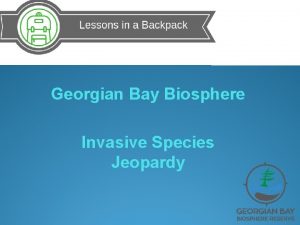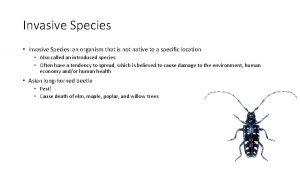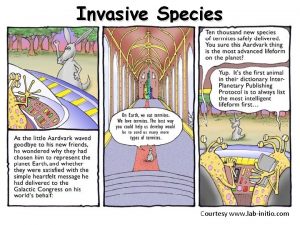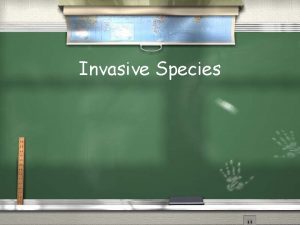Population dynamics of invasive and native species on


















- Slides: 18

Population dynamics of invasive and native species on the Galapagos Islands The Galapagos Islands have almost as many introduced species as native species. Many of the introduced species are invasive and are often either outcompeting native species or disturbing their habitat. Introduced goats Native vermillion flycatcher Native giant tortoise Native lava heron

1. Goats were introduced to a number of the Galapagos Islands several centuries ago. For the first 30 years after introduction, the goats lived under ideal conditions with unlimited space, unlimited resources and no predators. Which graph below shows how the goat population size would change during these 30 years?

2. If the goats were living under ideal conditions for 30 years after their introduction , which of the graphs below correctly shows how per capita birth and death rates would change with population density during that time?

3. To increase their understanding of the goat invasion, ecologists studied the per capita birth rate of goats on four different islands. They found that goat populations were more negatively affected by intraspecific competition (competition among the goats) on some islands than others. Use the graphs on the right to determine on which island the population was MOST negatively affected by intraspecific competition.

4. On the island of Northern Isabela the goat population grew rapidly for about 30 years, but then began to level off at a population size of approximately 10 000 individuals (see graph on the left). Which one of the four graphs on the right would BEST illustrate the same data points if the per capita growth rate for the population was plotted as a function of population density?

5. The goat population began to level off at a population size of approximately 10 000 individuals. Which ONE of the following statements provides THE BEST explanation for why the curve below levels off? A. B. C. D. E. Other species use up most of the resources The goat population has stopped reproducing The goats have used up most of the resources they rely on Competition among the goats inhibits further population growth Environmental factors inhibit further population growth

6. Ecologists studied goat population dynamics in areas that had been invaded to varying degrees. The population density varied among sites, but the availability of resources was about the same. The graph below shows how per capita birth and death rates vary with population density. What is the carrying capacity of the goat population on the Galapagos Islands? A. 400 individuals/km 2 (where the birth rate is 0) B. 0. 5 (the maximum birth rate) C. 0. 3 (the maximum growth rate) D. 250 individuals/km 2 (where birth rate equals death rate) E. 50 individuals/km 2 (the population size at maximum growth rate )

7. The lava heron is a native bird species that has decreased drastically since the goats were introduced. To gain insight as to why this bird species is threatened, ecologists studied different factors that affect its per capita death rate. Which ONE of the graphs below indicates that the lava heron population is regulated?

8. The table below includes additional data from the study on lava herons. Use the data to determine which ONE of the four factors acts to regulate the lava heron population. A. B. C. D. Competition for resources during the winter Competition for resources during the summer Predation Drought during the summer

9. Ecologists studied lava heron population dynamics to learn more about how its carrying capacity has changed on the Galapagos Islands. The graph below shows the per capita rate of increase (i. e. r or birth rate minus death rate) for ten different sites. The lava heron population density varied among the sites, but the availability of resources was about the same. What is the current carrying capacity of the lava heron population on the Galapagos Islands? A. B. C. D. E. 5 individuals/km 2 15 individuals/km 2 25 individuals/km 2 35 individuals/km 2 45 individuals/km 2

10. In order to learn more about the lava heron population ecologists collected demographic data at several study sites featuring different population densities (lava herons/km 2) of this species to determine which factors are responsible for regulating its population size. Based on the four demographic factors shown on the right, which graph shows the largest regulatory effect on the lava heron population?

11. The opuntia cactus is endangered due to disturbance by goats. The cactus was reintroduced to one of the islands, Española, where the goats had been completely eradicated. Ecologists studied the growth rate of the cactus population as it colonized different areas of Española Island. They calculated the per capita growth rate (low, medium and high) and plotted it as a function of population density (see graph on the left). Which one of the five graphs on the right would BEST illustrate the same data points if population size (number of individuals) was plotted as a function of time since reintroduction?

12. The giant tortoise is another threatened species on the Galapagos Island. Ecologists have collected birth and death rates from four of the islands (see graphs below) to investigate how different factors affect the population. Based on the four graphs on the right, on which island was the tortoise population MOST NEGATIVELY affected by intraspecific competition?

13. The suitable habitat for the tortoise population has decreased since the goat invasion. The carrying capacity for this species is therefore much lower on most of the Galapagos Islands than it used to be. The graph below shows how the change in population size from one year to another (i. e. lambda or Nt+1/Nt) varies with population density on the island of Santa Cruz. What is the current carrying capacity of the tortoise population? A. B. C. D. E. 5 individuals/km 2 15 individuals/km 2 25 individuals/km 2 35 individuals/km 2 45 individuals/km 2

14. Imagine that you are a conservation ecologist interested in determining which factors are responsible for regulating the tortoise population. You collect data at sites featuring different densities of this species and display these data graphically. Based on the four demographic factors shown on the right, which graph shows the largest regulatory effect on the tortoise population?

15. As a conservation ecologist you are also interested in learning how to facilitate the growth of small tortoise populations. It turns out that the tortoise population is affected by an Allee effect (i. e. it is difficult for tortoises to find mates when the population is below 30 individuals/km 2). Which of the four graphs on the right BEST describes how birth and death rates vary with density in a population that is affected by an Allee effect?

16. A. B. C. D. The Vermilion flycatcher is a small bird species native to the Galapagos Islands. Ecologists have been monitoring birth rates for this species for several years to learn why this species is threatened. Use the data in the table below to determine if the factors that determine birth rate regulate the flycatcher population or not. The factors regulate because the birth rate does not vary with density. The factors do not regulate because the birth rate does not vary with density. The factors regulate because the birth rate increases with increasing density. The factors do not regulate because the birth rate increases with increasing density.

17. Ecologists also studied factors that caused mortality in the flycatcher population. Use the data in the table below to determine if the factors that cause mortality in adult flycatchers regulate the population or not. A. The factors regulate the population because the mortality rate does not vary with density. B. The factors do not regulate the population because the mortality rate does not vary with density. C. The factors regulate the population because the mortality rate increases with increasing density. D. The factors do not regulate the population because the mortality rate increases with increasing density.
 Exotic species meaning
Exotic species meaning Invasive species characteristics
Invasive species characteristics Invasive species characteristics
Invasive species characteristics Invasive species characteristics
Invasive species characteristics Indiana invasive species council
Indiana invasive species council Invasive species laws
Invasive species laws Invasive species compendium
Invasive species compendium Invasive mushroom species
Invasive mushroom species Invasive species investigator worksheet
Invasive species investigator worksheet Invasive species investigator worksheet
Invasive species investigator worksheet Exponential growth of invasive species
Exponential growth of invasive species Are invasive species always bad
Are invasive species always bad Invasive species act ontario
Invasive species act ontario Population ecology section 1 population dynamics
Population ecology section 1 population dynamics Population ecology section 1 population dynamics answer key
Population ecology section 1 population dynamics answer key Population ecology section 1 population dynamics
Population ecology section 1 population dynamics Chapter 4 population dynamics study guide answers
Chapter 4 population dynamics study guide answers Define keystone species in biology
Define keystone species in biology Fish population dynamics and stock assessment
Fish population dynamics and stock assessment

